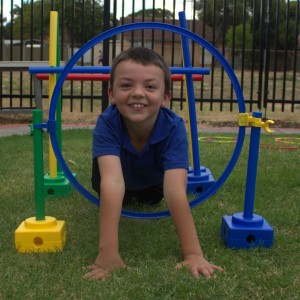 With long summer days and school holidays there is lots of time to play outside. At Talking Matters we have an outdoor therapy area because there are many benefits to learning outside. Parents can make outside play a time for learning too!
With long summer days and school holidays there is lots of time to play outside. At Talking Matters we have an outdoor therapy area because there are many benefits to learning outside. Parents can make outside play a time for learning too!
Outdoor activities are great for:
Developing large movement based skills. Outdoor activities such as trampolines, bikes, climbing, rolling, crawling, carrying, digging, pushing and pulling build gross motor skills such as balance and coordination, muscle strength and core body strength. Movement based activities also develop some of our senses too, especially our proprioception (awareness of our body in space) and vestibular (balance and movement) senses.
Developing fine movement based skills. Activities such as digging, pouring, building, painting, drawing and ball play help develop arm and hand strength, fine motor skills, visual perception skills, motor planning and eye hand coordination.
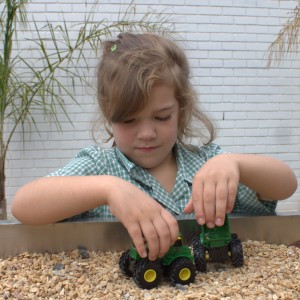 Developing sensory skills. Outdoor activities such as sand and water play, as well as activities on different surfaces such as bark, gravel and grass can provide sensory input to help children learn to process and regulate their senses.
Developing sensory skills. Outdoor activities such as sand and water play, as well as activities on different surfaces such as bark, gravel and grass can provide sensory input to help children learn to process and regulate their senses.
Developing communication skills. Communication is based on expressing needs and desires. Outdoor activities are highly motivating for many children and so can help develop communication skills such as requesting and choice making.
Developing language skills. A range of exciting experiences can help children expand their vocabulary. Movement based activities are especially good for learning verbs or action words which are vital for building sentences. Sensory activities are great for developing concepts such as size, texture, number and weight. Movement based activities help children learn prepositions or position concepts such as in, on, under and through. A range of other communication skills such as using grammar, sounds or sentence structures correctly can be built into activities.
Developing regulation. Outdoor activities including movement and sensory activities are great for helping children to be calm, focused and ready for learning.
How can parents support this learning?
If you child is having speech or occupational therapy, talk with your child’s therapist about your child’s goals and specific ways that you can support your child to further develop these skills.
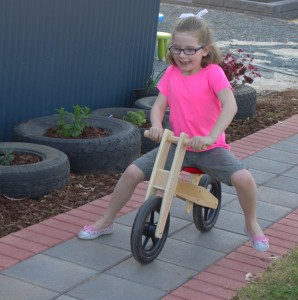 Whether your child is having therapy or not you can provide your child with a range of outdoor activities to support their development such as:
Whether your child is having therapy or not you can provide your child with a range of outdoor activities to support their development such as:
• visiting playgrounds for developing climbing, swinging, sliding and jumping
• outdoor play for running, jumping, hopping, skipping
• ball play for throwing, kicking, bouncing, rolling, skittles or bowling
• throwing at targets, through hoops, into boxes or baskets
• put a ball into a stocking, hang it on the clothes line and hit it with a hand or bat
• outdoor games such as chasey and follow the leader
• pushing, pulling and carrying with wheelbarrows and buckets of water
• bike riding and scooters
• balancing on planks, bricks, tyres, rope or masking tape lines
• go for a walk, run, skip, hop
• explore a local park, walk up a hill and roll down
• play hide and seek
• go to the beach and walk, run, swim and dig
• organised activities such as kinder gym, swimming, dancing and sports
• playing in a sandpit or in the garden, with sand, dirt, water or mud
Sometimes it is good to let children play independently but it is worth making time to play with your child too. When you play with your child outdoors at home and on outings try these things to help them develop new skills:
• watch what they do and encourage them to try new things
• talk with them about their experiences
• give them words for the things they can’t express themselves
• invite some friends to join in the fun
• take some photos and help your child share these with others
Some techniques to help your child develop new skills include:
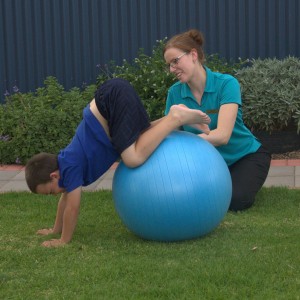 Modelling. This means showing your child how to do a new skill, while they watch you. They may try to copy straight away or they may needs lots of models before they have a go. You can model physical activities and speech and language skills too. Your child may be refining speech sounds and how to use grammar to combine words into sentences. You can help them fine tune these skills by repeating back what they say and fixing the mistakes “he got him shoes” yes “ he got his shoes”, “my tat” yes that’s your “cat”. Use a positive tone and emphasise the changes slightly to draw your child’s attention to the correct form. Repeat it a few times for extra practice “he’s your cat, he’s a big cat, pat the cat”.
Modelling. This means showing your child how to do a new skill, while they watch you. They may try to copy straight away or they may needs lots of models before they have a go. You can model physical activities and speech and language skills too. Your child may be refining speech sounds and how to use grammar to combine words into sentences. You can help them fine tune these skills by repeating back what they say and fixing the mistakes “he got him shoes” yes “ he got his shoes”, “my tat” yes that’s your “cat”. Use a positive tone and emphasise the changes slightly to draw your child’s attention to the correct form. Repeat it a few times for extra practice “he’s your cat, he’s a big cat, pat the cat”.
Expanding You can help your child learn to use longer and more complex sentences as you play together by adding a word to one they say. “mummy look a big leaf” Yes "look a big, brown leaf” Your child does not need to copy you. Just hearing what you say will help and they will use that new word when they are ready. If they do try to copy you though, respond positively. You can use expansion for things other than speech too. Watch your child play and copy what they do then add and extra step. If they are throwing a ball you could model a bounce, then a throw. If they are drawing lines with a crayon you could model lines going up and then back or lines that turn into waving lines.
Hand over hand support. Some children find it hard to watch and copy. They may learn physical skills better if at first they are guided though the movement by an adult hand over theirs. You may find it is helpful to support the movements with some simple words, but not too many, such as "scoop, up, then tip" for putting sand in a bucket.
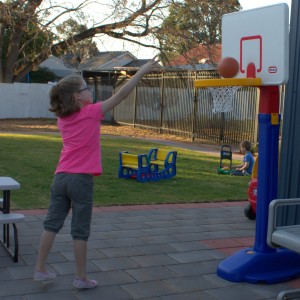 Backward chaining: This technique works well for physical activities. First break new tasks into achievable steps. You could help your child with most steps but encourage them to try the the last step on their own. Later try the last two steps, then the last three and so on. For example you might start by helping your child climb the slide and position themselves at the top, then encourage them to slide down by themselves. Next you might help them to the top of the ladder and encourage them to sit on their own then slide and so on until the are doing the whole process by themselves.
Backward chaining: This technique works well for physical activities. First break new tasks into achievable steps. You could help your child with most steps but encourage them to try the the last step on their own. Later try the last two steps, then the last three and so on. For example you might start by helping your child climb the slide and position themselves at the top, then encourage them to slide down by themselves. Next you might help them to the top of the ladder and encourage them to sit on their own then slide and so on until the are doing the whole process by themselves.
Forward chaining: This works the same way but your child does the first step then you help them with the rest. First your child may put sand in the bucket, you may pat it down, turn it over and help them take the bucket off to make a sandcastle. Next they may fill the bucket and pat it down and so on.
Using visuals. Visuals can help kids learn in all kinds of ways. Visuals are anything your child can see, including symbols, pictures and for some kids words. Because visuals don't "disappear" like spoken words they can help kids learn and retain information. You might use a series of symbols to show the steps in a task or a map to show where you are going. You might take some photos and use these to help your child talk about what they did later on. You can read more about visuals for younger kids here and older kids here.
Now you have lots of great techniques to help your child learn new things here are some fun activity ideas to work on new skills. For whichever activity you choose think about how you can develop your child's large and fine movements, sensory and communication skills.
Some great things to try outdoors include:
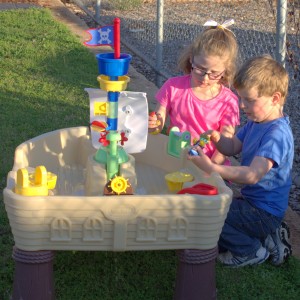 The backyard
The backyard
- plant a garden
- peg out the washing
- wash the car
- make a sandpit
- make a cubby
- put up a tent
- play in water
- make a mud pie
- wash the dog
- make a bird feeder
The beach
- dig a hole
- build a sand castle
- collect some treasures
- play in the water
- feed the seagulls
- fly a kite
- float a boat
- go for a walk
- take the dog for a swim
- draw pictures or write in the sand
The park
- climb a tree
- roll down a hill
- have a picnic
- walk the dog
- collect treasures
- play on the playground
- make an obstacle course
- follow a map
- feed the ducks
- ride a bike or scooter
The bush
- look for wildlife
- climb a hill
- compare and contrast colours, size and textures
- explore and pretend
- have a treasure hunt
- collect pictures of things you see and talk about them
- make some rubbing pictures
- listen for different sounds
- look for animal footprints
- follow a trail
If you are concerned about your child's development including play skills, motor or sensory skills, communication skills, social skills or learning check our website to see how Talking Matters may be able to help. For more ideas and resources check the resources section on our website and our extensive Pinterest page. Like us on Facebook and follow us on Twitter so you don't miss out on what's happening.
Talking Matters provides speech pathology and occupational therapy. If you would like to work with our great team in our bright, child-friendly, therapy space find out more about Talking Matters and our services and resources by checking our website or calling our office on (08) 8255 7137.
Remember to always supervise your child, keep them safe and protect them from the sun. We hope you and your child have lots of fun learning outdoors!
Related Blog Posts
If you liked this post you may also like:
Mastering Buttons and Fasteners
Dressing - Supporting Your Child's Development
School holiday ideas for children
50 ready to read ideas



